Archive for category October 2019
Qingdao, A Chinese Gem Along the Yellow Sea
Posted by admin in October 2019, Past issues on October 14, 2019
By Kollengode S Venkataraman
I was on business in Qingdao, a major city in Shandong Province in Eastern China. It is on the western shore of the Yellow Sea, with the South Korean shore to the east, around 500 miles across. With a population of 9 million, it is China’s 18th largest population center. China’s Guangzhou’s population is 45 million; Shanghai’s 35 million; Beijing’s 22 million; and Chengdu’s 18 million. So, you can call it a second-tier city of China. By comparison, Allegheny County’s population is 2 million.
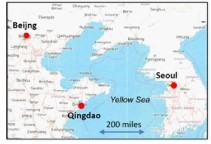
A major city in China’s One Belt One Road (OBOR) Initiative that connects Asia with Europe, it has the highest GDP of any city in the province. Qingdao is a major seaport, has a naval base, and is an industrial center. It has the longest sea bridge (over 17 miles long), linking the main urban areas, straddling the Jiaozhou Bay. The bridge was designed and built by Chinese engineers to survive larger typhoons and earthquakes.
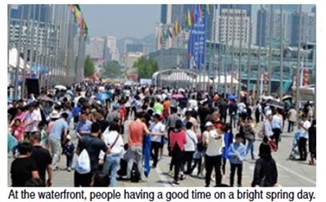
Thanks to German colonization during the 19th century, Qingdao is also famous for Tsingtao beer, and has the second largest brewery in China. With its long coastline along the bay, it has several beautiful beaches and vista points. In 2018, the Shanghai Cooperation Organization held its summit in Qingdao, in a sprawling brand-new building specially built for the meeting. Several heads of states participated. The aquatic portion of the Summer Olympics 2012 was held in Qingdao.
With so many high-visibility events staged in Qingdao, the whole area has received much attention from China’s governments. They have executed massive infrastructure projects against tight schedules.
The prosperity among China’s organized sectors is visible everywhere. In fancy malls, people are in fashionable clothes; they have the latest models of high-end cell phones and European automobiles. They spend their weekends in fancy, mostly Chinese restaurants, and in excellent open-air entertainment centers, . Even with divided 4- and 5-lane city roads, they have traffic jams during peak hours.
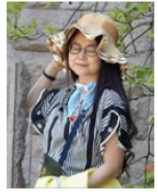
During my stay, on a weekend, my colleague Robin Cao showed me around Qingdao’s waterfront and cityscape, and restaurant scene. It was a pleasant, mild, sunny spring day. Flowers were part of the sidewalks in the city, and not just in any park. You can imagine how many resources the city government spends on beautification!
China has the widest possible choices in food. In one grocery store, different sizes and types of eggs from a variety of birds were on display. You have to see to believe the range of vegetables, grains, noodles, and Chinese buns like our modaks with all kinds of vegetarian and nonvegetarian fillings. And for seafood fanatics and meat-eaters, the choices are endless, with a whole range of fish, crabs, lobsters, turtles, and other reptiles (including snakes); in addition to pork, chicken, beef, lamb, and goat, you also get wild game, and also body parts of large animals such as livers, brains, tongues, etc. A whole range of tropical and subtropical fruits are available, both locally grown, and imported from Malaysia, Thailand, Vietnam, and Indonesia.
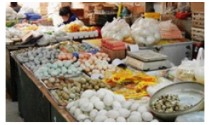
Even as a vegetarian, I had no problem in getting what I wanted in restaurants. When I went with my colleagues, they took care of me. But on several occasions, I explored the restaurant scene all by myself. No one speaks English and they are not embarrassed or apologetic about it. After all, 1.3 billion people speak Mandarin.
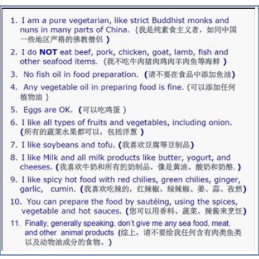
So, language was a big problem for me in exploring the restaurant scene all by myself. I asked my colleague Robin to prepare for me a list of my food restraints written in English and translated into Mandarin. See the figure on the side. In restaurants, the waiter and I would exchange the menu card and my card on food preferences. The waiter would look at it, giggle/smile/chuckle and take me around for me to pick what I wanted from among the items on display. I was never disappointed with what I got.
The many pictures shown here tell you how far China has come. Yes, there is poverty and there are ghettoes. Show me one American or European city that does not have their share of poverty-stricken areas, where working class and poor people live servicing the needs of the affluent.
I had the privilege of having an elaborate 15-course all-vegetarian dinner that my colleague Robin hosted for me in his elegant apartment near the Qingdao University with the mountain range as the backdrop. His wife Jessy, who teaches computer science at the university, was the most gracious host; she told me that in her entire life, this was the first time she had ever made an all-vegetarian luncheon for their guest. Robin and Jessy live with his mother and his 20-year old daughter Anne, who is pursuing her IT degree at Qingdao University.

Instead of writing long passages on how the Chinese have adapted to Western influences, the two pictures of women in restaurants shown below can be a metaphor on how China deals with Western influences. I took the pictures in random restaurants where I was having my meals. These women were total strangers to me. (I got their permission for the pictures.) They were elegantly dressed; the woman in the red dress is having her Belgian waffle; and in the other picture, the woman is having a tandoori roti.


I took the pictures in different restaurants on different days. Waffle is a European breakfast item, and tandoori roti is an Indian item. And without giving up or modifying their lifestyle, and without any embarrassment, they were elegantly using chopsticks to eat food items from all over the world. And there are millions like them all over China.
This goes beyond their eating habits. They are comfortable in being Chinese, even when they become affluent and college-educated. They do not want to change their essential Chineseness. All through the Communist Revolution of the Mao era and the economic boom initiated by Presidents Deng and continued by Xi, the core tenets of Confucian values are still strong. In this regard, the Chinese, Koreans and Japanese are quite different from Indians.
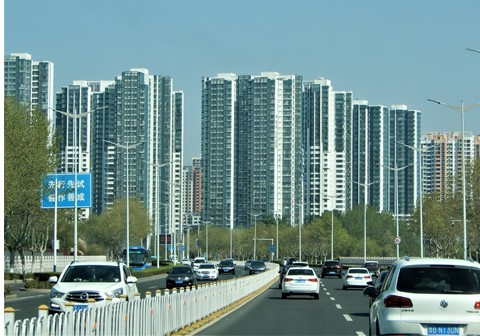
Twenty- and thirty-story high apartment complexes are scattered all over China to meet the ever-increasing demand for the affluent professional middle class. Since no one can own land in China (they can be only taken on 100-year leases), the affluent invest in apartments as a hedge against inflation. This has given rise to a unique situation of having large apartment complexes with only 60% or 70% occupancy. Arab sheikhs, Russian oligarchs, and Indian/Chinese tycoons do the same in London, Paris and New York. Same story with NRIs in urban India.
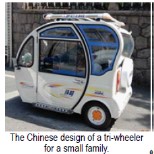
On the Qingdao bay, the young and affluent Chinese were relaxing in their yachts and speed boats. And in the plaza, a whole bunch of people varying in age from 85 to 2 years and toddlers — great grandparents, sons and daughters and grandkids — were enjoying the sun.

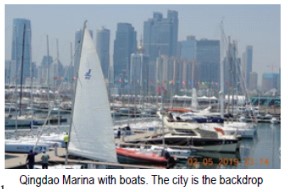
Even on a bright day, some days, the sky was muggy due to pollution. But the government is hell bent on doing its best to reduce the carbon footprint. Public buses and light rail transits are increasingly becoming popular among youngsters.
In China taxis are retired after a certain number of years or after a certain number of kilometers on their odometer. So, taxis are relatively new and clean. All taxis are metered and accept credit cards. I was surprised that in all my rides, the taxi drivers did not wait for my tip, and refused even when I offered, as did waiters in restaurants. This is a huge difference between the US on the one hand, and Europe, China, and Japan on the other. Maybe the money they earn in these occupations given them enough incomes. In the US, waiters in restaurants live only on their tips. In most places in the US, their hourly salary is around $3.00 per hour. Taxi drivers in the US will frown if you don’t tip them.

I was getting ready for my return journey early in the morning. I got into the taxi. The taxi driver turned the ignition key on and pressed a button. A 1-minute audio tape came on asking me one last time: Did you check your passport? Did you check your flight is today? Did you check in already? Do you want to check anything else before we go?
It was a 40-minute taxi ride to the airport. Along the way, the driver wanted to ask me a few details about my flight. He opened an app and said something in Mandarin. The English translation came: Which airline? Domestic or International? Flight number? Departure time? I replied in English and he got the translation in Mandarin. That is how far advanced China is.
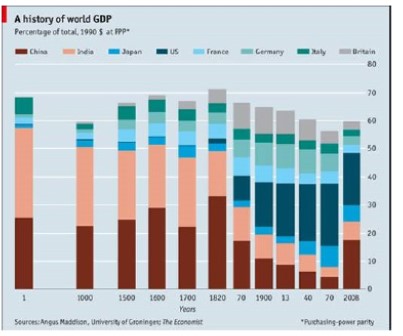
It took China over 70 years to become a vibrant and confident nation to challenge the Western and Japanese domination in the 20th century from the feudal society that it was before Mao’s Revolution. For 1700 years up to the Industrial Revolution, the world GDP of those times was split between India and China. See the adjacent chart. China is fast regaining its past, lost glory. It has become the manufacturing hub for the rest of the world. Its technology base is good and getting better by the day, and its business acumen is something for the rest of the world to worry about. It has developed its own version of the bullet train. It is close to develop a commercial equivalent of the Boeing 737 and Airbus 320 for its own market, which is huge, and later for the Asian market. There is reason for the U.S. and EU to worry. The rest of the world has a lot to learn from China on what to do and how to do it; and, more importantly, how to adapt modern technologies to local conditions. If other nations are smart, perhaps they may even learn how o avoid some of China’s missteps along its path of rapid growth. $$$$
Home:
25th Year and Going Strong!!
Posted by admin in October 2019, Past issues on October 13, 2019
By Kollengode S Venkataraman
The Pittsburgh Patrika enters its 25th year. Reaching this milestone for a financially and editorially independent small-town Ethnic Media publication is noteworthy. Publishing is a time-consuming job requiring attention to detail, working against deadlines from the get-go. Editing, proofing, and laying out in the format, then getting it printed and mailing them for free to 1800-plus addresses every three months takes time.
By choice, we do not seek financial support from any social, political, cultural, religious, or other entity. We pay all our ever-rising bills through our advertisements. Three of our readers on their own send us unsolicited small contributions every year. We owe a big Thank You to all our advertisers and these supporters for their trust in our integrity.
People living among us find time to write articles for the magazine, informing readers about many topics. All the stories in the magazine are about ourselves or on a topic that interests our readers. And deliberately we stay away from the juicy Indian filmi tidbits and also from local gossip. After all, are we all not naked underneath our clothes?
The Pittsburgh Metropolitan Area, with a population of nearly 2.4 million, is the 22nd in the nation. The Indian population in our area is only around 20,000, yet we do have vibrant practitioners of Indian classical and contemporary dances, and vocal and instrumental music, with support from a handful of individual patrons. We can do better with more ticket-buying audiences, given our better education, higher earnings and net worth.
As is the case with all print publications, the Patrika too is facing tremendous headwinds in these days of information overload and other social media choices being available. TV and cell phones have cut into our reading and writing on complex issues. This is a global trend.
In the next several issues, you will see occasional reprints of articles from yester years. In the meanwhile, bouquets and brickbats from readers on the magazine’s 25 years of journey are also most welcome. $$$$
Home:
Affordability of the Retirement Communities in India and in Pune City
Posted by admin in October 2019, Past issues on October 13, 2019
Balwant Dixit, Pittsburgh, PA E-mail: bdixit@pitt.edu
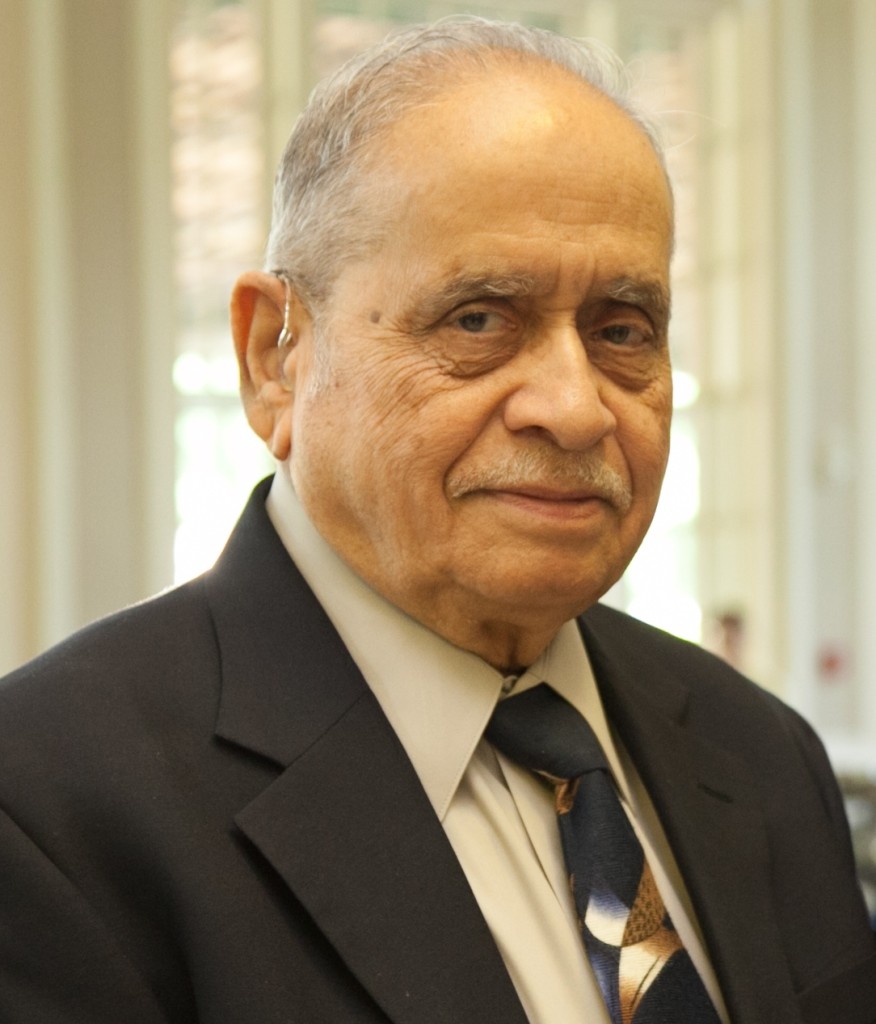
In recent years, many reports describing the beginning of a new era in providing much needed shelter, well prepared meals and affordable basic medical care to an estimated 100 million senior citizens of India have appeared in Indian papers and magazines. Not to be outdone, several Indian publications and organizations in the USA have given glowing reports of the retirement communities established in India. Simultaneously, in the USA efforts are underway to build retirement communities for Indians with great enthusiasm. Such stories in print give Indians living outside India and in India a sense of accomplishment and make them feel confident that the problems senior citizens in India are facing will rapidly be solved by just building a few more retirement communities in India. However, if one looks at the ground reality in India one cannot escape the conclusion that the solutions to the difficulties the 100 million seniors in India are facing today are far from being realistically addressed to.
The majority of India’s current population is less than 30 years old. The traditional joint family system that works in safeguarding the social and economic security of the seniors has been lost. With the emergence of nuclear family, many seniors are exposed to emotional, physical and financial insecurity. In countries like India the magnitude of economic insecurity is very high with more than half of seniors in India are dependents.
According to the 2012 census, the population of India was 1210 million, with a close to 100 million (8.6%) seniors. By 2026 the population of seniors expected to increase to 175 million. Currently, there are 35-40 large independent retirement facilities or communities in India, located in Bangalore, Hyderabad, Dehradun, Chennai, Delhi, Coimbatore, and Pune and in few other cities. The cost of 1BR and 2BR condos in these communities ranges from Rs. 45 lakhs ($50,000) to Rs. 15 crores ($250,000). In addition, monthly service charges range from Rs. 35,000 to 80,000. However, the demand is outstripping the supply by such a wide margin that facilities are sold out before even they are completed. Assisted care, Nursing Care, Alzheimer and Memory Care services are also now available at some of the retirement communities, but costs are very high. Nationally, with the average occupation ranging from 300 to 600 seniors in each of these facilities they can accommodate not more than 15,000 seniors. Usually, the buyers of condos in such facilities are from the top 1% of the Indian population or rich NRIs returning home or some of them buying condos for their old parents living in India. Most of such facilities are located within or near the large urban areas, with relatively easy access to hospitals and large shopping complexes.
Apparently, there is a significant need for these types of relatively high priced facilities in India. For example, a new private, not-for-profit trust, Age Ventures India (AVI), has recently been established to start planning construction of retirement facilities in Bengaluru, Ahmedabad, and Greater Gurgaon area. AVI is partnering with HelpAge India for knowledge sharing and with the USA based Pacifica Senior Living for various aspects of strategic planning. AVI plans to offer comprehensive services necessary for the welfare of the senior citizens
In addition to these large retirement facilities, almost every city in India such as Pune, Mumbai, Delhi, Chennai, Bengaluru, Mysore, Kolkata, Hyderabad have 15 to 20 small retirement facilities offering a mix of amenities such as long or short stay, assisted care, memory care, hospice care with 2 to 4 beds in each room. The quality of bedroom furnishings and associated furnishings vary significantly from one to the other. Meals are usually provided and the monthly service fee ranges from Rs. 40,000 to 70,000 and some facilities even charging up to Rs. 50,000 to get on the waiting list. Such small facilities are always located within the city limits for easy access to medical care and other amenities. These small size facilities can accommodate an additional estimated 6000 seniors.
HelpAge India is a leading charitable organization working with and for seniors and older people in India for the past 40 years. It runs a gamut of programs with the aim to serve needs of elders in a holistic manner, enabling them to live active, dignified and healthier lives. HelpAge India has established 26 old age homes for the seniors in places such as Patiala, Tamil Nadu, Mumbai, and Kolkata accommodating estimated 2,000 seniors and old age persons. Their facilities can provide comprehensive support to their inhabitants at a relatively low costs since HelpAge operates principally on donations they receive from individual donors, corporations and Trusts & Foundations.
All these facilities collectively can accommodate a total estimated 30,000 seniors, i.e. about 0.003% of the total senior population, leaving 99% of the seniors in need of affordable retirement facilities. How that can be done is a big question that defies easy answers since verifiable data on the needs of seniors is not available.
There are several hurdles in the planning of future facilities in India. No oversight agencies or regulations to monitor the financial stability of the retirement communities. Nearly a total lack of reliable data about the living and economic conditions, social profile, and assistance available for the activities of daily living (ADLs), the primary caregiver and the health and nutrition across the population of seniors. There is no standardization of services and costs associated with them. The Indian population is divided into rural (65-70%) and the urban (35-30%). Only scant data are available is on a small sample of the urban population. The value system and family dynamics is different in many respects when one compares the rural and urban population of seniors.
The relevant questions that need to be answered are: How many of the estimated 100 million seniors can afford to move away from their current place of residence and live away from their relatives to live independently? How many can afford to pay for their health care?
In India there are laws that allow the parents to sue their sons and daughters who refuse to provide financial support to them. In cities like Delhi, Mumbai and Pune there are examples of aged parents suing and winning cases against their children for kicking them out. In some of the metropolitan areas and in rural communities there are cases of sons or daughters dropping or abandoning their elderly mothers where they are given help by NGOs and Mandirs for survival.
In 2016 the Tata Institute of Social Research completed a survey, “The Situational Analysis of Elderly in Pune City†about the seniors in Pune City on the conditions senior citizens are living and the difficulties they are experiencing on a day to day basis. The survey evaluated (i) Living conditions (ii) Economic conditions (iii) Social profile (iv) Activities of daily living (ADLs) and instrumental activities of daily living (v) Primary caregiver (vi) Health and nutrition.
This type of study is a rare in India, while a lot of credible studies related to the problems faced by seniors have been conducted in the West. The Pune City was selected because it is one of the fast growing cities in India and has been touted as the retirement capital of India. In 2016, the population of Pune was 6 million, with seniors estimated at 500,000 (8.5%); greater than 30% of them living in slums.
Currently there are four (55+) independent living retirement facilities (Athashris) and an estimated 20 small Continuing Care Retirement Community (CCRC) type facilities in Pune. The cost for a one BR condo is about Rs. 45-60 lakhs in Athashris. Monthly service cost in a CCRC type of facilities varies from Rs. 35,000 to 45,000. All these facilities together can provide housing for only about 2000 seniors i.e. for 0.005% of the estimated population of seniors in Pune.
The main conclusion of the survey indicates a very difficult situation being faced by seniors in Pune, with the conclusion that these types of facilities are unaffordable for the 99% of the seniors in Pune. To make the situation worse politicians of every political persuasion announce before the election that they intend to build retirement facilities in every town and villages in India if elected, and after getting elected, they comfortably forger there promises. $$$$
Home:
Dekho Hamara Hindustan — Story of A Missing Elephant
Posted by admin in October 2019, Past issues on October 13, 2019
Premlata V
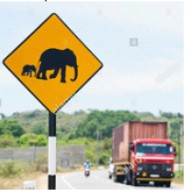
This could happen only in Hamara Hindustan. An elephant went missing, not in one of the Kerala-Karnataka Temples where elephants are part of the temple retinue. And not in their natural habitat in the Western Ghats in Tamil Nadu, Kerala and Karnataka, where road signs display elephant corridors warning motorists of herds of wild elephants crossing — like deer crossing signs here. Remember, these winding roads in India go through the natural forest habitat of the elephants. So, on these roads elephants have the right of way over motorists for road crossings. See the picture below.
But this elephant went missing in July this year in — hold your breath — of all the places, metropolitan New Delhi with a bulging population of over 18 million people. And Laxmin, the elephant, was the only one in the entire Delhi Metro area at that time.
According to the story in the Indian Express (September 17, 2019), the missing elephant Laxmi kept the Delhi Police and wildlife officials on its tail since July, with a nationwide alert being sounded. The 35-year old pachyderm was last seen along the banks of the Yamuna. But Laxmi was kept right in New Delhi all the while by her mahout Yusuf Ali.
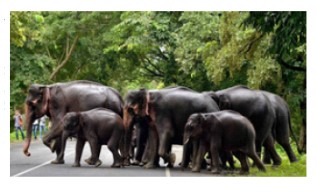
The relationship between elephants and its owners and mahout is symbiotic. Often, elephants outlive their mahouts and when the mahouts die, elephants weep in grief and refuse food for days.
Delhi’s wild life officials said in early January, Laxmi and five other elephants in Delhi were kept in “poor housing and health conditions and lack of suitable space and water facilities in Delhi, violating the 2008 guidelines by the Union Environment Ministry.â€
One wonders why these “wild life†officials don’t recognize the wild species of Homo sapiens in Delhi living in fancy high-rise apartments living their “wild lives†with impunity.
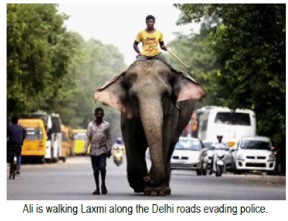
In mid-September, The Indian Express staff met the elephant’s owner Yusuf Ali (45), who was with Laxmi in Delhi. Evading arrest, Ali said he and Laxmi never left the capital. Initially, he “hid†Laxmi in a wooded area along the Yamuna.
One of Ali’s friends then told Ali he had a large farmhouse where he could keep Laxmi. And that is where she had been ever since she went “missing.†Ali took her out every evening for a walk for about an hour or two. Ali would occasionally step out of hiding to buy food for Laxmi and to meet his family. Even when he didn’t have enough to eat, he took care of Laxmi. He would arrange a 500-litre water tanker every day along with sugarcane and jowar.
Mr. Ali now has a non-bailable warrant against him under IPC sections 353 (assault or criminal force to deter public servant from discharge of his duty) and 186 (obstructing public servant in dis-charge of public functions). Ali says he will abide by the court’s decision. “This is my elephant, and I have an emotional attachment with it.†$$$$
Home:
Uncertainty for the Near Future in South Asia
Posted by admin in October 2019, Past issues on October 13, 2019
By Kollengode S Venkataraman
All abrupt changes need time for adjusting to new realities. With India making J&K a Union Territory, the Line of Control is now the de facto International Border. The on-again-off-again India-Pakistan diplomatic relationship will be off-again for the foreseeable future.
For starters, there will be only minimum diplomatic contacts between India and Pakistan. The already dormant South Asian Association for Regional Cooperation (SAARC) is now dead, buried in Pakistan and cremated in India. Pakistan has banned direct trade with India, even though it benefits its economy and its working poor, given the economic crisis Pakistan is experiencing. People-to-people contact are gone. It may close its space for airlines for all flights to and from India.
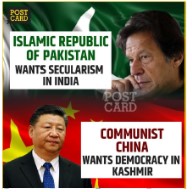
In his tweets, speeches, interviews and writings, Imran Khan repeatedly throws incendiary terms like fascist, racist, Nazi, Hitler, Mussolini, ethnic cleansing, Hindu Supremacists and Muslim persecution, when referring to Modi and his government. This he does to whip up anti-India, anti-Hindu feelings in Pakistan and draw the Western media’s sympathy.
Pakistan, given its severe economic crunch, cannot afford a full-scale conventional war stretching even a few weeks. So, border skirmishes will be the norm, with frequent terrorist attacks in J&K and elsewhere in India. The two countries spying on each other will intensify. Military and security outlays will increase further, possibly hurting Pakistan more.
Given the severe strains in Pakistan’s economy and its aam-aadmi problems, its faujis will not be interested in a coup. The current arrangement of having a pliable, weak prime minister allows it to let the elected nominal government face all problems, while appearing to keep its hands clean.
If Pakistan’s military thinks it has nothing to lose — or the loss it will inflict on India will far more severe — nothing will stop it from initiating skirmishes in Kashmir that could escalate into war. In desperation, Pakistan’s military may even consider the nuclear option. Imran Khan repeatedly warns the world of this possibility, trying to force the global powers to intervene. But even an adventurous and foolhardy military will count its beans before getting into a mess much bigger than what it can handle.
For India too, conventional war with Pakistan will impede its efforts to leap forward from new projects critical for its growth to catch up with China on many fronts. But if Pakistan attacks India again as it did in the Indian Parliament in 2001 and in Mumbai in 2008, India will be forced to respond.
The several invectives that Imran Khan raised against Modi on the abrogation — like changing the demographics of Kashmir, ethnic cleansing, ill-treating minorities and others — are more applicable to Pakistan. The Hindu population in Pakistan in 1971 (after the Bangladesh war) was nearly 2.9%. Now it is around 1.7%. Pakistan’s Hindus, Christians, Ahmedis, and Sikhs complain about violence against them and their women. Balochs complain that Pakistan’s Punjabis and Sindhis are changing the demographics of Baluchistan, the mineral rich, thinly populated region. Christians, Sikhs and Hindus are prohibited by law from holding the office of president, prime minister, or chief Justice, or in the military. Ahmedis are hounded out and persecuted, and cannot even contest elections. And Pakistan has already changed the demographics in the part of Kashmir it occupies and in the Gilgit/Baltistan region with people from the Punjab. Pakistan-occupied Kashmir is now directly administered by Islamabad. So, on these matters, Imran Khan has to only stand in front a mirror before accusing Modi.
The real winner are the Ladakhis. People in Jammu have welcomed the abrogation. The Ladakhis, now in a directly administered Federal Region after the abrogation, are ecstatic since they will be no longer exploited by Kashmiris in Srinagar and in the Valley. While the Muslims in the Valley in J&K complain about New Delhi’s domination, they have been dishing out the same thing to Hindus in Jammu and to Buddhists in Ladakh. The Ladakh region has been exploited and neglected since 1947 in every way possible by the Kashmiri Muslim political leaders.
This article would be incomplete without presenting the plight of the Kashmiri Hindu Pandits, who are part of the larger Saraswat Brahmin community. The Kashmiri Pandits’ contribution to Indian intellectual life has been enormous through the millennia. Here are some of the big names: Charaka (300 BC, the father of Ayurveda); Vishnu Sharman, the author of Panchatantra (300 BC); Nagasena (200 BC) Buddhist Scholar; the famous Kalidasa (5th century AD); Somananda, the famous teacher of Kashmir Saivism (9th century); the polymath Abhinavagupta (10th century); Utpala, a mathematician (10th century); Kalhana, poet and dramatist known for Rajatarangini (12th century); Sarngadeva, the musicologist (13th century AD); and the list goes on.
In the 1980s, over 450,000 Pandits were in the Kashmir Valley, having lived there for millennia. The Jammu-Kashmir Liberation Front run by Muslim separatists, securing money and arms from Pakistan and other sources, targeted the Pandits and their women with gruesome violence and threats of violence and drove them out of the Valley. Now, hardly 3000 Pandits live there. Their exodus from the valley is hardly highlighted as ethnic cleansing, even in the Indian media.
[Many Kashmir Pandits converted to Islam over several centuries, and are now prominent political leaders. Kashmiri Muslims carrying the same DNA as the Hindu Pandits are responsible for the ethnic cleansing of the Hindu Pandits. That should send a chill through anyone’s spine.]
In the next few years, if the Modi government proves that it is serious about delivering all things to the people of Jammu & Kashmir and Ladakh that the abrogation of the articles promises, there is a good chance that after some hiccups and initial difficulties, ordinary Kashmiris in the valley will see their own self-interest and accept the abrogation. This will weaken the hands of the militants and the Hurryat separatists asking the Kashmiri youth to indulge in violence, thus jeopardizing their future. It is unconscionable that the Hurryat leaders live in relative comfort in Kashmir, and their sons and daughters live in and outside India leading placid, secure lives as doctors, engineers and professors. Kashmir deserves a respite from the corrupt Abdullahs, Muftis, Gandhi satraps, Hurryat leaders, and the violence let loose by the separatists and the terrorist outfits with Pakistan support. $$$$
Home:
Chinmayananda’s Mahasamadhi Day Celebrated with Reverence
Posted by admin in October 2019, Past issues on October 13, 2019
By Ganesh Krishnamurthy, Volunteer Chinmaya Mission Pittsburgh
Chinmaya Mission Pittsburgh (CMP) hosted its first Chinmaya Mahasamadhi Camp from July 29th to Aug 4th at the Doubletree Hotel in Greentree. The camp is an annual week-long family spiritual retreat for people active in the Chinmaya Mission, and is also open to the public, hosted by different centers in North America. San Diego and Chicago hosted the last 2 camps.
The camp’s thrust is to celebrate the life of Swami Chinmayananda, a great exponent of the Hindu Vedantic teachings in the 20th century. Swami Chinmayananda left this world on August 3, 1993 in San Diego and the annual camp culminates on Aug 3, with a devotion filled Mahasamadhi puja.
The main topic for this year was Krishna Leela and was presided over by Pujya Swami Swaroopananda of the Chinmaya Mission. The attendees also heard discourses by Swami Shantananda on Chapter 8 of the Bhagavad Gita and Swami Prakashananda on Purajana Gita.
The organizing team of volunteers endeavored to make the campers like the members in Gokul and Vrindavan with exhibits and murals of child Krishna.
To help complement Swami Swaroopananda’s discourses, several well-known episodes of Lord Krishna’s stories — like Krishna’s birth, Kaliya Mardhanam, and Raasa Leela — were brought to life through dance recitals staged by members of Chinmaya Mission. Abhang recitations, and painting jugalbandi were other attractions.
On August 3, all participants offered a Mahasamadhi Puja showing their veneration to Swami Chinmayananda. A highlight of the day was the traditional Kerala-style authentic meal on banana leaf in remembrance of Gurudev who was from Kerala. A separate exhibition showcased pictures, quotes and audio clips of Gurudev.
Many guests associated with Chinmaya Mission for a long time were thoroughly impressed with how the retreat was organized and said this was the “best they have gone to.†Guests also visited the Sanjeevani ashram and the SV Temple on one of the afternoons. Guests were amazed that Pittsburgh, in spite of being a smaller city, had places of worship, spiritual centers and a thriving cultural network, supported by a warm and well-connected Indian community.
Pittsburgh has a special connection to Gurudev since he came to Pittsburgh in the 70’s. He said Pittsburgh’s confluence point of the three rivers reminded him of the Triveni Sangam in Prayaag. For members of the Pittsburgh branch of the Chinmaya Mission who had met and interacted with Gurudev, it was a special and emotional moment to host the camp in Pittsburgh. The members of the Chinmaya Mission of Pittsburgh acknowledge with gratitude the support and help they received from members of our community in various ways for making the retreat a memorable one. $$$$
Home:
Prthvi ka Swarg Pittsburgh — A Poem in Hindi
Posted by admin in October 2019, Past issues on October 13, 2019
By Acharya Jagdish Chandra Joshi
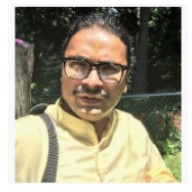
Acharya Jagdish Chandra Joshi was born in the Indian state of Uttarkhand at the foot hills of the Himalayas. His high school education was at Haridwar. His father, Joshi says, never pushed him into any field, but insisted that he does well in the field he chooses. So modern!! His family was steeped in Sanskrit linguistic traditions. So, he was naturally towards Sanskrit classics. After topping his class in high school, when Joshi went to Varanashi, he was the first in his family, may be in his entire village, to go to the place for higher education in Sanskrit. He earned his master’s degree in Sanskrit literature. He also learned vocal and instrumental music there, along with Vedic literature. Working as a Pandit at the Hindu-Jain temple since 1999, Joshi has traveled all over the U.S. for conducting various services for Hindus.
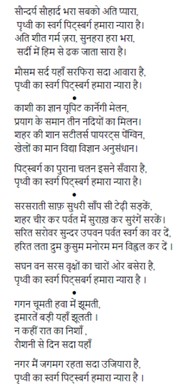
$$$$$
Home:
The Jammu-Kashmir-Ladakh Conundrum Straightened Out and Yet Not
Posted by admin in October 2019, Past issues on October 13, 2019
By Kollengode S Venkataraman
The complex history of Kashmir from all perspectives is scattered throughout cyberspace. Atul Singh and Manu Sharma’s recent summary What Lies Behind India’s Bold Bet on Kashmir? in the on-line magazine Fair Observer is an example.
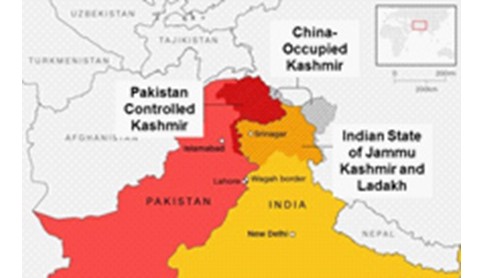
Pakistan does not even recognize Articles 370 and 35A of the Indian constitution, which, in 1954, gave special status as a temporary measure to India’s Jammu & Kashmir (J&K) state after its accession in the 1947 Partition. In 1947, when Kashmir’s king Hari Singh joined with India, Pakistan sent its forces and took control of part of Kashmir. The maps below show how Kashmir is split among India, Pakistan, and China, with the former two claiming the whole of Kashmir. The Line of Control (LoC) is the current de facto border.
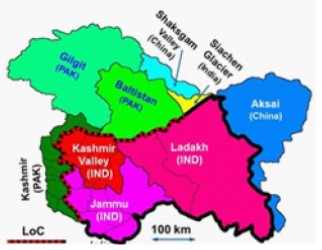
To begin with, the two articles in the Indian constitution, included as temporary measures, are discriminatory Women face disparities in property and marriage rights vis-a-vis men. There is no constitutional protection for the Scheduled Castes and Scheduled Tribes and minorities. Indians are prohibited from a) claiming residency in the state no matter how long they have lived there, b) acquiring property, c) getting assistance from government programs, and d) securing government jobs and scholarships for children in colleges.
These factors and the continual violence, particularly in the Kashmir Valley, has not helped in developing the region in the last thirty years, compared to the rest of India. But as happens with any government, once you put any rule to suit the need of the hour, vested interests take over, making it impossible to change them.

In the meantime, Kashmiris have spread out all over India establishing themselves, buying properties, running businesses, educating their children, and getting all the other benefits of the Indian citizenship.
The Kashmir issue is the “jugular vein†for its military and its politicians. So, Pakistan tries to “internationalize†India’s August 5 abrogation of Articles 370 and 35A, even though it does not even recognize them. Pakistan’s military has perpetuated its iron grip on Pakistan’s government and resources, penetrating Pakistani society through the thousands of businesses the military runs. So, India as an eternal threat is necessary for the military to continue its hold on Pakistan’s civil society.
In the politics of the J&K state since 1947, only a few families have had influence and control: the Abdullahs (Sheikh, his son Farookh, and Farookh’s son Omar); the Muftis (Mohammed Sayeed Mufti and his daughter Mehbooba); the Lones and the Ansaris; and finally, the Nehru/Gandhi family’s satraps. Corruption in public life in any system with only a handful of families having power for generations needs no explanation. This is endemic throughout India.

Given the pre-British bloody history of the region and how India and Pakistan violently sliced the region between themselves during Partition, it is impossible to mediate an acceptable solution. On Kashmir, there are more than two parties — the governments of India and Pakistan, Pakistan’s military, hardliners in each country, Kashmiri separatists, and then, China. So, the ulcerous issue has festered for over 70 years.
The British colonial occupiers left India in reckless haste in 1947, letting the “native coolies†fend for themselves and sort out the issues. If they thought that the ensuing confusion and violence would keep their influence and control on the natives, they were mistaken. Over the past 70-plus years, all options have been tried to resolve the issue:
a) Pakistan-initiated outright wars in 1965, 1971 and 1999; continual stealth operations by Pakistan across the LoC and in the Kashmir valley through the decades; and providing “political, moral, and diplomatic†support (which means providing arms, money and intel) for the Kashmiri separatists and terrorists; b) hyped up summitry between the India-Pakistan heads of governments, secret back channel contacts between government-approved interlocutors; c) soft power people-to-people contacts, sports and cultural exchanges, and train and bus services across the border; d) improving trade that will obviate the very idea of “borders†in the globalized world; e) nuclearization of the region with tens of atom bombs by India and Pakistan (and China) with sophisticated delivery systems with historically ominous names (Pakistan’s Ghauri, Gaznavi, Abdali, and Babur missiles). But nothing has worked.
President Trump’s unsolicited, gratuitous mediation offer was the tipping point. In diplomacy, Trump is as nuanced as a wild raging bull in a china shop. So, nobody took seriously the unsolicited mediation offer — not to mention the arbitration offer — he flippantly and irresponsibly threw at TV reporters when Pakistan’s Prime Minister Imran Khan visited the White House last July. The unsolicited offer Trump made was lapped up by Pakistan as a game changer in this intractable issue. In a way, it indeed was, but not in the way Pakistan wanted. India never wasted time in saying publicly “Thanks Mr. Trump, but no thanks.†Later, with Trump at his side at the G-7 meeting in France in August, Modi declared that all India-Pakistan issues “are bilateral†and will be resolved bilaterally.
In India all political parties, in principle, have committed to scrap the Articles, which were, after all, temporary measures. The Congress Party has been whittling down their provisions over the years. For the Bharatiya Janata Party (BJP), scrapping the articles was a public declaration. The BJP returned to power in the May 2019 elections with even a greater majority than what it got in 2014. In public discourse, this has been debated ad nauseam. Besides, as reported by TCA Sharad Raghavan in The Hindu, (July 24, 2016),
“Jammu and Kashmir [alone] has received 10 per cent of all Central grants given to states [during] 2000-2016, despite having only one per cent of the country’s population… … In contrast, Uttar Pradesh [with] about 13 per cent of the country’s population received only 8.2 per cent of Central grants in 2000-16. That means J&K, with a population of 12.55 million according to the 2011 Census, received Rs.91,300 per person over the last sixteen years while Uttar Pradesh only received Rs.4,300 per person over the same periodâ€
The Modi government saw the atmosphere was ripe (see the article below) for scrapping J&K’s temporary special status. So, on August 5, it moved resolutions in both houses of the parliament scrapping the two 70-year old articles from the Indian constitution. In doing so, it incorporated Jammu and Kashmir as a federally administered area with its own elected legislative body; and the Ladakh/Kargil region, to be directly administered by the Federal government in Delhi. n
The Timing of the Decision
In politics, timing is everything for bringing about far reaching, fundamental changes. Just consider these factors the Modi government would have considered before scrapping Articles 370 and 35A.
1. For the second time, the BJP returned to power in the May 2019 national elections with an even greater majority and approval. It is unlikely that this will be repeated again in the next general election in 2024. The fragmented Indian opposition parties are in disarray. The Congress Party has lost its moorings — even its relevance — in Indian politics with its sycophantic senile leaders genuflecting in front of the inept Gandhis. In the parliament, no party even qualifies as the official Opposition party.
2. Pakistan has problems on multiple fronts. Imran Khan is a weak prime minister without a majority in the parliament, picked for the job by Pakistan’s powerful military. In fifteen months in power, he has put key opposition leaders in jail. The Human Development Index (taking into account literacy, access to health care, gender equality, living standards and other measures) of Pakistan is poor, 150th among 189 nations. India’s is only slightly better, at 130/189. Pakistan has accumulated massive debt. In the last 25 years, it has gone to the IMF 13 times (including in 2019) for bailouts. Each time the loan was given under tighter conditions. The Pakistani rupee has lost 30% of its value in the last 12 months; its stock market has taken a similar beating. Srging inflation and unemployment are hurting the working poor. Pakistan’s influence in the Muslim Ummah, even with its nuclear weapons, is not where it wants to be vis-a-vis India’s. There is resentment among the Balochs over exploitation and neglect. Sindh has its own simmering problems with Punjab and with Mohajirs (the Urdu-speaking descendants of Muslims who moved from India to Pakistan in 1947).
3. As mentioned earlier, politicians, diplomats, back channel folks and outside interlocutors are not able to resolve the issue. Pakistan-initiated wars, infiltration and the arming of separatists — even the nuclear weapons with missiles — have had the same effect.
4. Major global powers have their own issues – Russia with Crimea; China in Tibet, Hong Kong, and in handling the Muslims Uighurs; the US with Mexico and illegal immigrants. Besides, Iraqis and Syrians and others from Muslim nations are seeking political/economic asylum in Europe, US/Canada, while other rich Arab nations (Saudi Arabia, the Persian Gulf countries, Kuwait) are simply standing by.
5. The world is weary of the Kashmir issue that has been festering for over 70 years. In the UN General Assembly’s annual fall jamboree, every time India and Pakistan talked on Kashmir, the delegates yawned. These addresses were only for local consumption in India and Pakistan.
6. The EU is in its own mess with Brexit. The United Kingdom in today’s world is irrelevant. The Empire imploded decades ago.
7. The world economy is faltering after 12 years of expansion. With Trump’s tariff wars on the rest of the world, free trade is now dead with far-reaching implications. So, Kashmir is peripheral to many leaders.
8. India has a better technology base. The goodwill capital of millions of Indians working in many countries as engineers, doctors, teachers, carpenters, electricians, construction workers and taxi drivers is getting transferred to India. But the Indian economy — and the global economy as well — has been faltering lately.
With the erratic Trump, the Sole-Super-Power U.S. has no gravitas on the world stage. Trump is now a caricature.Trump’s gratuitous unsolicited mediation/arbitration offer was the proverbial Indian crow landing with a jerk on a bough of a tree with a fully ripened fruit ready to fall at any moment. Trump’s gratuitous offer was the jerk.
Thus, tactically, the time could not have been better for the Modi government to take a deep breath and scrap Articles 370 and 35-A in one stroke through legislation. And it did so on August 5, 2019 with a better than 2/3 majority in both houses of the parliament, despite the BJP not even having a majority in the Rajya Sabha (the Upper House). The Supreme Court will remember this when the case reaches its doors. $$$$
